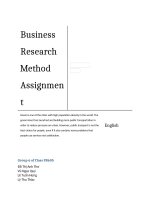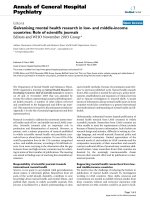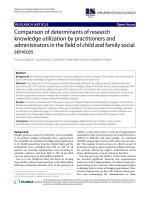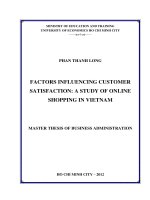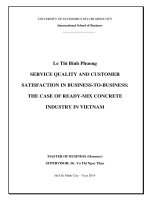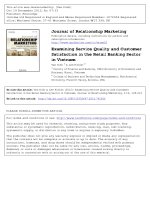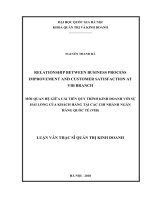final essay business research method online retail experience and customer satisfaction mediating role of last mile delivery
Bạn đang xem bản rút gọn của tài liệu. Xem và tải ngay bản đầy đủ của tài liệu tại đây (2.98 MB, 32 trang )
<span class="text_page_counter">Trang 1</span><div class="page_container" data-page="1">
TON DUC THANG UNIVERSITY BUSINESS ADMINISTRATIVE INTERNATIONAL BUSINESS ADMINISTRATIVE
FINAL ESSAY
BUSINESS RESEARCH METHOD
ONLINE RETAIL EXPERIENCE AND CUSTOMER SATISFACTION: MEDIATING ROLE OF LAST MILE DELIVERY
Lecturer Nguyen Trung Tin : Group: 1
Shift: 3, Tuesday
</div><span class="text_page_counter">Trang 2</span><div class="page_container" data-page="2">TABLE OF CONTENTS
DIGITAL RETAIL EXPERIENCE AND CUSTOMER GRATIFICATION: THE
INTERMEDIARY PART OF LAST MILE DELIVERY. ... 1
1. A<small> BSTRACT</small> ... 1
2.I<small>NTRODUCTION</small> ... 1
3. L<small> ITERATURE REVIEW</small> ... 3
4. O<small> NLINE RETAIL EXPERIENCE AND CUSTOMER SATISFACTION</small> ... 4
5. L<small> AST MILE DELIVERY IN E RETAIL EXPERIENCE</small>- ... 6
</div><span class="text_page_counter">Trang 3</span><div class="page_container" data-page="3">TABLES OF FIGURES
T<small>ABLE AMPLE EMOGRAPHICS</small>1: S D ... 9 T<small>ABLE EASUREMENT</small>2: M ... 12 T<small>ABLE INAL ESTIMATED MODEL</small>3: F ... 13
</div><span class="text_page_counter">Trang 4</span><div class="page_container" data-page="4">PERFORMANCE AND PARTICIPATION EVALUATION Group 1:
No. Student
Evaluation (%)
1 721D0014 Triệu Thị Minh Nguyệt
100%
3 721D0031 <sup>Nguyễn Ngọc Thanh </sup>Tâm
5 721D0058 Nguyễn Uyên Nhi
- Literature view part- Managerial implications- Format
100%
6 721D0051 Ngô Thanh Duyên
- Introduction part &Abstract
- PPT
100%
</div><span class="text_page_counter">Trang 5</span><div class="page_container" data-page="5">Digital retail experience and customer gratification: the intermediary part of last mile delivery.
1. Abstract
Recent years, the extraordinary expansion of e-commerce has been vital for different businesses around the world. Enabled by the Internet retailers are able to contact more customers, extend the distribution network much further, and utilize their sources more efficiently. Customer experience has developed as a font of competitive precedence in the new market environment. This study looks into customers’ experience in online shopping which is affected by the function of the last mile delivery. A study that was performed in Vietnam and analyzed the latest experience of participants was used as a part of quantitative methodology. The finding shows that the association between the customers’ assessment of online purchasing experience and customers’ satisfaction is mediated by the last mile delivery. These assumptions are the foundation for more in-depth research of last mile delivery’s function in the e-retail context and reinforce online sellers in raising their online shoppers’ satisfaction. 2. Introduction
Global e-commerce has experienced tremendous development in recent years as a consequence of the Internet's quick expansion and soaring consumption rates. Worldwide e-retail revenues were $2.3 trillion in 2017 and are predicted to reach $4.9 trillion in 2021 (eMarketer, Statista, 2022), Undoubtedly, e-commerce not only redefines the practices of numerous businesses (Oinas, 2010); (Wagner, 2013); (Schramm-Klein, H., and D. Morschett, 2006)but also forms the value of its information advantage differentl (Baozhuang Niu, JianDong, ZhipengDai, YaoqiLiu, 2022) redefines the y practices of numerous businesses (Oinas, 2010) (Wagner, 2013); (Schramm-Klein, H., ; and D. Morschett, 2006). By 2019, almost half of China's citizens will be shopping online, and nearly 80% of US Internet users will buy online at least once (eMarketer, Statista, 2022). In both developed and developing economies within countries, a similar trend can be seen, as the entire. In 2020, the number of digital consumers is forecast to surpass 2 billion (eMarketer, Statista, 2021)
When the combined market value of e-retail goliaths like Amazon and Alibaba is similar to the GDP of Mexico or Spain, the rising market consistently generates revenue records. By creating e-services, digital media, and hardware and changing their focus to long-term relationships with their clients, the front runners go outside the realm of traditional retail. To take advantage of customers' experience and obtain a competitive edge in this market competition (Neil F. Doherty, Fiona Ellis‐Chadwick, 2009), e-retailers engage in the contemporary approaches and enhanced technology in accordance with customer
</div><span class="text_page_counter">Trang 6</span><div class="page_container" data-page="6">demands (Mosa, 2022). E-retailers are turning to logistics to provide personalized services, point to the end customer is generally seen as a significant criterion for online consumers (Heleen Buldeo Rai, Sara Verlinde, Cathy Macharis, 2018); (Terry L. Esper, Thomas D. Jensen, Fernanda L. Turnipseed, Scot Burton, 2011) (Murfield, M., C. A. ; Boone, P. Rutner, and R. Glyn Thomas, 2017). Last-mile delivery options that customers like include free delivery, same-day delivery, deliveries at certain times, in-store pickup, shipment tracking, and free return shipping. According to PwC's Global Consumer Insight Survey (PwC, 2018), online buyers place high importance on quick and flexible delivery. Consequently, last-mile delivery is to be quite important to online customers. Recent e-commerce and retail research have established a strong customer experienceagenda (Pandey, S., and D. Chawla., 2018) in order to properly address the rising and internet shoppers' expectations are rapidly altering. The achievement of a profound knowledge of the client experience has made the topic become a complicated and multifaceted endeavor. Recent research have revealed a multistage perspective for comprehending consumer decision-making and the shopping experience is suggested comprehending. (Lemon, K. N., and P. C. Verhoef., 2016)present a model which combines the pre-buy, purchase, and post-purchase stages which constitute the customer journey spanning a continuous cycle of previous, current, and future client interactions. In the effort to comprehend and improve client experiences across many industries, such a model is quite relevant. However, e-retail studies mostly concentrate on the online experience of customers, while other stages have not gotten fair attention in research. Once the key functions and touchpoints are determined, the multistage approach appears to be a strong fit for the online retail customer experience. For instance, drawing parallels to the bricks-and-mortar retail model, one can claim that the consumer's experience with online shopping is incomplete until they have the desired item in their possession. Following this argument, it is proposed that one of the many core components of the e-retail experience is the last-mile delivery experience. While the delivery and return processes are essential in determining the customer's e-retail experience, e-retailers still view these activities more as needs than as potential sources of customers’ satisfaction and loyalty. Evidently, the results of the delivery and return services will have an impact on the consumer's relationship with particular online shops (Marshall Fisher, Santiago Gallino, Jiaqi Xu, 2016) However, many e. -retailers have a shortage of value chains by adding non-optimal options.
By examining the effects of last-mile delivery on customer satisfaction, this research employs a more comprehensive perspective on the customer's e-retail journey. More specifically, the role of last-mile delivery as a go-between for customers' online experiences and their general happiness with the e-retail experience. The scientific data gives retailer managers a different angle on the online customer experience and a means of generating customer value, both of which promote customer happiness and trust. This
</div><span class="text_page_counter">Trang 7</span><div class="page_container" data-page="7">work adds something modest but original and significant to the amount of knowledge already available. The proposed model establishes the foundation for future retail to adopt the customer journey concept and enhances the integration with customer orientation approach, which is gaining attention, but still has room for improvement (Mariola Palazón, Manuela López, María Sicilia, Inés López, 2022).
3. Literature review
In modern marketing, envisioning a brand is viewed as an experience for the customer. Over the past few decades, user experience has been the subject of extensive studies overthe last few decades (Kranzbühler, A. M., M. H. P. Kleijnen, R. E. Morgan, and M. Teerling, 2018). And the concept of customer experience was originally introduced by (Holbrook, M. B., and E. C. Hirschman, 1982) who argued that only a fraction of customer behavior is determined by the value and pricing perceptions of consumers. Instead, a concept gai ned depth with a holistic view of customer experience was introduced, which included hedonic, symbolic, physical, social, economic, environmental, and aesthetic factors. It endorsed a multistage aspect that featured the connection between past, present, and future customer experiences (Verhoef, 2009) It . has recently been discovered that future customer experience is a consequence of customer-firm engagement and is in some ways influenced by the customer's consciousness of a firm's customer experience management output. As a result, it is somewhat impacted by how people evaluate the outcomes of their companies' customer experience management efforts. The customer experience, according to (Christopher Meyer, Andre Schwager, 2007), is a reflection of the subjective reaction that customers exhibit in both their passive and active interactions with the business. Since the perception of experience results between the business and the consumer might differ greatly (James Allen, Frederick F. Reichheld, Barney Hamilton and Rob Markey, 2005) (Kranzbühler, A. M., M. H. P. Kleijnen, R. E. Morgan, and M. Teerling, 2018), this dyadic perspective on user experience production is conceptually essential. More specifically, the characteristics of a consumer's individual experience are associated with the values, impressions, and emotions that vary from one customer to some other, as well as from one business within a particular service industry, to another (Awad, 2022) Traditionally, a business's understanding of the consumer experience is turned into a set of methods for ensuring customer pleasure with the goal of fostering consumer trust and increasing profitability for the business (Frow, P., and A. Payne, 2007). The desire to seek information and the intention to make future online purchases were both positively
</div><span class="text_page_counter">Trang 8</span><div class="page_container" data-page="8">impacted by a satisfactory and enjoyable experience while making an online purchase transaction (Shareef et al., 2019). This viewpoint is typically based on the blueprint approach, as recommended by earlier studies (Mary Jo Bitner, Amy L. Ostrom, and Felicia N. Morgan, 2008). But in the setting of escalating industry competition, customer experience has been broadly acknowledged as the source of competitive advantage and long-lasting customer loyalty (Pine, B. J., and J. H. Gilmore, 2011); Verhoef et al. 2009); (Mascarenhas, O. A., R. C. Leventhal, R. Kesavan, and M. Bernacchi, 2006)An increase in experience-centric concepts and companies can be attributed to this change in values. According to this new viewpoint, businesses should create and promote their products and services as a series of transactions (Verhoef, P. C., G. Antonides, and A. N. de Hoog., 2004); (Patrício, L., R. P. Fisk, J. Falcão E Cunha, and L. Constantine, 2011). In this view, a customer's experience is a series of reactions to a series of contact points that make up the customer journey and begin a long time before the customer makes a purchase or interacts with the company (Lemon, K. N., and P. C. Verhoef., 2016).A shop or service provider may find it difficult to identify all of the touchpoints, which can result in insufficient customer journey maps, a disjointed awareness of the customer's perspective, and a lack of influence over customer management stages..
A survey found that only 8% of customers agreed with the assumption made by 80% of businesses that they offered superior experiences (James Allen, Frederick F. Reichheld, Barney Hamilton and Rob Markey, 2005). This gap has been narrowing in recent years as businesses began to see customer experience management as a means of enhancincustomer satisfaction and gradually made the switch to a "get out and look" strategy for accomplishing this goal. Additionally, no trustworthy customer experience scales have been created, and the ones that are already in existence have not yet demonstrated theirutility owing to their recent development and restricted applicability (Lemon, K. N., and P. C. Verhoef., 2016).
4. Online retail experience and customer satisfaction
Numerous merchants have changed their marketing plans and distribution methods as a result of the rapid development of e-commerce, which has also changed how they interact with customers and vice versa. E-commerce provides access to distant markets because it is said to blur international boundaries (Suwarni et al., 2020). The customer experience evolved a fresh collection of factors as the retail context moved to an online format. (Mathieson, M., and J. Hoskins, 1995) (Parasuraman, A., V. A. Zeithaml, and ;
</div><span class="text_page_counter">Trang 9</span><div class="page_container" data-page="9">L. L. Berry, 1985) and (Zeithaml, V. A., A. Parasuraman, and A. Malhotra, 2002)were the first studies to highlight important Internet retail characteristics, and they were successful in showcasing the areas where the online and offline retail environments diverged. Despite numerous attempts by researchers to compile a list of the essential characteristics, no consensus has yet been reached. An online store can be assessed baseon a variety of frequently used factors, such as its usability, personalization, product selection, and clarity of the information provided about it, clear pricing, the accessibility of the desired goods, order tracking, on-time delivery, the product fulfilling expectations, customer support features, the overall appearance and style of the site, and retaining customers (Burke, 2002) (Ruby Roy Dholakia, Miao Zhao, 2010) (Jin, B., and J. Y. ; Park, 2006) that produce many sorts of customer value and serve as a benchmark for the consumer e-retail experience.
In the environment of e-commerce, implementing a customer journey point of view to engineer customer experience becomes a tremendous effort (Lemon, K. N., and P. C. Verhoef., 2016). Customer journey is closely related to customer experience, which is the internal and subjective responses customers have towards contacts with service providers (Yiqing Ding, Erin F. MacDonald 2022). When customers cannot be watched throughout their interactions with a range of interactions, customer behavior becomes less transparent, making it difficult to recognize and place many touchpoints on a customer journey map. Since it takes into account that customers have experiences whenever they "touch" each and every component of a product, service, image, or business across many platforms and media, the principle of touchpoint is extremely intuitive and plain, and is therefore helpful (Pantano and Viassone 2015). Consumers now communicate with businesses throughout a variety of touchpoints across different publications and networks (e.g., social network sites (SNSs), apps, websites, and physical stores), leading to more complicated journeys that are partly based on recent dramatic changes in consumer habits and purchasing behaviors (Melero, Sese, and Verhoef 2016). However, a lot of retailers use big data and in-store behavior monitoring to keep an eye on client behaviors and create accurate customer profiles. Customer behavior has changed in response to shifts in the retail environment, which has driven to modifications in customer satisfaction mechanisms (Ballantine, 2005); (Harvir S. Bansal, Gordon H.G. McDougall, Shane S. Dikolli, Karen L. Sedatole, 2004); (Szymanski, D. M., and R. T. Hise, 2000)
</div><span class="text_page_counter">Trang 10</span><div class="page_container" data-page="10">The evaluation of online customer experience, as opposed to that pertaining to a retailer or online marketplace, advances the current knowledge of the interactions between the consumer and the retailer. The construction of customers' impressions and expectations of an online store is strongly influenced by their online experience (Pappas, I. O., A. G. Pateli, M. N. Giannakos, and V. Chrissikopoulos, 2014). According to multistage perspective studies, self-efficacy, perceived effort, perceived utility, and simplicity of use are strongly correlated with prior online purchasing experiences (Tong, 2010).In the future, a mix of these factors and their linkages will determine the behavior of customers (for instance, retention and favorable word of mouth) and the degree of faith they have with the retailers (Hahn, K. H., and J. Kim, 2009). It will be challenging for businesses to build lasting relationships with their customers without loyalty (Setyorini & Nugraha, 2016). Safety, privacy, and dependability are aspects of trustworthiness (Harwood & Garry, 2017). The intention to repurchase a product or service will show up when consumers perceive that the goods acquired may satisfy them, which will help to improve the experience of shopping online through faithfulness and satisfaction among customers. The primary aim of customer experience management is to increase customer happiness, which is connected to these and other aspects of the customer experience (Liu, X., M. He, F. Gao, and P. Xie, 2008) (Lee, G. G., and H. F. Lin, 2005) ; (Janda, S., P. J. Trocchia, and K. P. Gwinner, 2002). In accordance with the results of prior studies, we hypothesize that:
Hypothesis 1: Consumer satisfaction and online customer experience are positively correlated.
5. Last mile delivery in e-retail experience
Three decades of inquiry about customer e-retail experience have produced a fragmented and rather limited knowledge regarding the link between delivery processes and the e-retail experience. There has been substantial advancement in the understanding of the customer e-retail experience over the past three decades (Trevinal, A. M., and T. Stenger, 2014),however, there are still limitations in the knowledge regarding the delivery processes associated with the customer e-retail experience. An initial investigation with reference to customer e-retail experience has proved that customer satisfaction levels can vary between the stages of online retail checkout and after delivery, so that delivery affects overall customer satisfaction (Jiang, P., and B. Rosenbloom. 2, 2005) . Last mile delivery which comes from the last upstream shipment point to the end consumer is
</div><span class="text_page_counter">Trang 11</span><div class="page_container" data-page="11">periodically considered a vital decision-making benchmark for online shoppers (Esper et al. 2003; (Murfield, M., C. A. Boone, P. Rutner, and R. Glyn Thomas, 2017); Buldeo Rai, Verlinde, and Macharis 2018). Nonetheless, accessible discoveries reveal a connection between the customer's recognition of the online experience and their experience following a parcel's conveyance. Reliable delivery has been mentioned as a source of customer value in e-commerce (Keeney, 1999). The key indicator that positively plows into customer satisfaction with parcel locker services is timeliness, whereas accuracy and security are similarly the predictive coefficients, according to responsiveness and tangibility, separately (Po-Lin Lai, Hyunmi Jang, Mingjie Fang and Ke Peng 2022). Factors such as free delivery, same day delivery, in-store pickup, on-time delivery (Gregory R. Heim, Kingshuk K. Sinha, 2001), price, and total delivery time (Swaminathan, J. M., and S. R. Tayur., 2003) (Marshall Fisher, Santiago Gallino, ; Jiaqi Xu, 2016) have been accepted as precedents to customer satisfaction and fealty to an e-retailer. In 2017, according to Amresh Kumar and Bhawna Anjaly, their study determined that the extent for measuring OPPCE (online post-purchase customer experience) is multi-dimensional. It consists of six dimensions which are conveyance, product- -hand, return and exchange, customer support, assets and feel-good elements. inThe accurate focus on the items of these measurements can help e-retailers advance customer experience and escalate repeat purchase. From the customer experience viewpoint, cognitive discord over conveyance impacts customers's awareness of the online shopping experience (Liao, T. H., and C. J. Keng, 2013)
As consumers tend to appreciate an e-commerce experience from a holistic aspect that is out of obviously distinguishing which of the participating market factors is responsible for which mechanism (Tax, S. S., D. McCutcheon, and I. F. Wilkinson., 2013)it could be concluded that a negative delivery result will make a breakthrough in overall customer satisfaction and in the future consumer relationship with a given e-retailer. Consider the pattern in which a client purchases an item online but, in spite of an immaculate online shopping experience, the conveyance experience clears out the customer dissatisfied (for example, the parcel contains the off-base item or the parcel is taken to a very troublesome pickup location). Due to this, customers may switch to different e-retailers in an endeavor to avert future service failures and disappointments. On t he point of the e-retailer is the factor which firms the delivery options for the consumer to choose from, it is expected that a well-designed online purchase experience takes into account consumer conveyance requirements and can hence have a positive effect on the last mile
</div><span class="text_page_counter">Trang 12</span><div class="page_container" data-page="12">delivery process. Following these beliefs, and in line with previous research, we hypothesize that:
Hypothesis 2: The last mile delivery experience provides a mediating relationship between the online experience and customer satisfaction.
6. Methodology
6.1 Sampling and data collection
This study uses quantitative research methods. Self-administered online questionnaires were used as an approach in this survey with the help of Google Form. The questions used to ask the participants were invented based on former papers that was merticulously collected and calculated b y the group of authors. Participants in the survey were randomly selected from many e-commerce pickup spots in Ho Chi Minh City, Vietnam. Ho Chi Minh City was selected as an appropriate location for this study because it has 567 e-commerce sites, over 20.680 websites and 134 apps that provide commercial services (Hang, 2021). The participants were given the chance to answer questions on their most recent e-retail experience after already being briefed upon this study's objectives, confidentiality, and voluntary nature of their participation. The Shopee vouchers, worth 10.000 VNĐ, were given to each participant after they completed the survey. The survey was given to the participants in their home tongue of Vietnamese. The information for the study includes 170 valid respondent responses, which includes 69 percent of females and 31 percent of male with an average life expectancy of 18 - 25 years. The demographic sample is shown in Table 1.
Table 1. Sample Demographics
Categories Frequency Percentage in the sample
</div><span class="text_page_counter">Trang 14</span><div class="page_container" data-page="14">commerce experience (for instance, the root and type of product bought, the purchasing time, the interaction and relation between consumers and online buyers, and the pickup procedure).
The test of reliability through these aforementioned controls which gives impressive outcomes in the degrees of internal consistency. Cronbach’s alpha for online-purchasing experience, perceived last mile delivery, and overall customer satisfaction was 0.935, 0.924 and 0,847 respectively.
7. Results
Partial Least Squares Structural Equation Modelling (PLS-SEM) was used to evaluate the structures. An examination of the factor loading reveals that some of the subjects that were previously included to reflect the before-during-after experience did not match the convergent validity requirements and were thus eliminated from the study (see Table 2). We have a conviction that it is related to the multifaceted expertise and that the components are collecting a greater range of consumer expertise than is reflected in the model terms of consumer expertise. Certain patterns may be seen even if we don't make judgments based on the factor loadings.
Table 2. Measures
Factor
1.1 It’s easy to find any product on
1.2 I received the necessary
Purchase Confirmation. <sup>0.741 </sup>1.3 It’s easy to do the steps. 0.815 1.4 A clear return policy. 0.704 1.5 A seller provides many choice
1.6 I feel safe when buying online
</div><span class="text_page_counter">Trang 15</span><div class="page_container" data-page="15">1.7 All the important information was provided to me when shoppingonline.
0.782 1.8 Online experience tailored to
Consumers' commitments and assumptions.
0.765 1.9 I feel enjoyable when shoppin
online.
0.829 1.10<small>a </small> The online seller is reliable. - 1.11 I controlled the process. 0.805 1.12 I enjoy buying online products 0.832
Customer experience in last-mile delivery 0.924 0.928 0.654 2.1<small>a </small> I received exactly what I
ordered.
- 2.2 On-time order delivery. 0.748 2.3 All the necessary information
about my order was supplied.
0.829 2.4 A suitable type of delivery was
pickup location.
- 2.8 I feel safe in process of
transport experience. <sup>0.846 </sup>
3.1 I feel contented with the
process of shopping. <sup>0.824 </sup>3.2 I have the right choice during
3.3 I want to recommend the delivery unit to other people.
0.782
</div><span class="text_page_counter">Trang 16</span><div class="page_container" data-page="16">The validity loadings for online seller (1.10) seemed less than 0.7, consequently indicating their low importance in terms of the satisfaction and experience of the buyer. The bulk of the measures that were kept in the final models related to how satisfied customers were with their experiences - blissfulness (2.11) and being in grasp (2.10) of the last mile delivery expertise, and comfortable sense (1.9), grasp (1.11) and safeness (1.6).
We performed a mediation study in accordance with Hayes' recommendations (Hayes, 2013) to determine if the expertise of a last mile delivery assistance mediates the impact that online expertise has on consumer contentment. Respondents without gender and age information were eliminated, while participants were considered outliers for the assessment measures if their z-scores were higher than an independent point of 3.00 standard deviations. Finally, 170 replies were accepted for study after all outliers in the data set were gotten rid of.
The last estimated model shows a strong correlation between online expertise and buyer contentment: β = 0.271, SE = 0.094, t = 2.801, p < 0.005, which is illustrated in Figure 1. This is consistent with hypothesis 1, which holds that a satisfying online expertise increases buyer satisfaction. The findings also show the importance of the last mile -delivery path from online expertise: β = 0.821, SE = 0.035, t = 23.584, p < 0.005. This shows that customers report having better last-mile delivery experiences have also had better online experiences. Moreover, we can also observe that the relationship between last-mile delivery and consumer satisfaction is important: β = 0.821, SE = 0.035, t = 23.584, p < 0.005. Customer satisfaction with the entire e-retail experience is directly impacted by the last mile delivery expertise is indicated.
3.4 I’ll keep using this delivery service. 0.860
These subjects were evaluated on a 7-point Likert scales (1 = strongly disagree; 7 = stronglCR = composite reliability, AVE = Average Variance Extracted.
<small>a</small>item deleted during the purifying process of measures. Table 2: Measurement
</div>